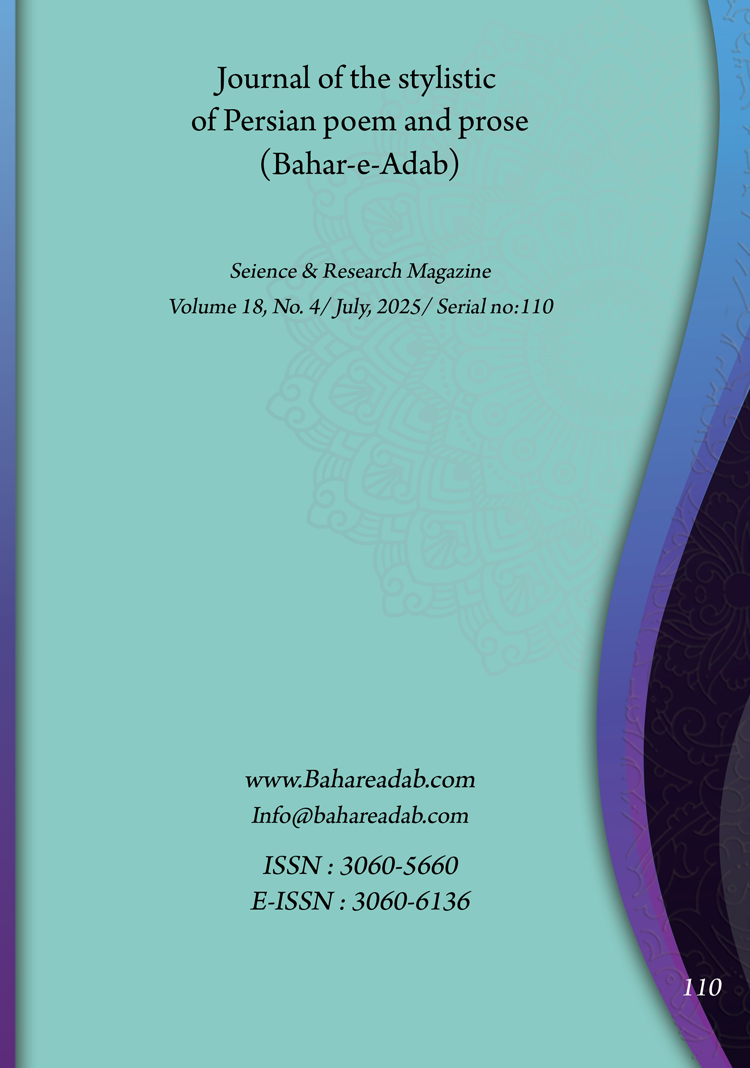- Count View : 88
- آدرس کوتاه شده مقاله: https://bahareadab.com/article_id/1844
- کد doi مقاله: Doi: 10.22034/bahareadab.2025 .18 .7864
Journal of the stylistic of Persian poem and prose
volume Number 18،
number In Volume 4،
،
issue Number 110
Study and Analysis of the Lexical and Rhetorical Structure of the Mathnawi of the Eskandari Kheradnameh by Nour al-Din Abd al-Rahman Jami Based on the Layered Stylistic Model
Farzaneh Foroozani (Author in Charge)
Abstract
BACKGROUND AND OBJECTIVES: One of the methods of contemporary stylistics is layered stylistics, which examines and analyzes various works in an intratextual manner and based on the creative layers that include lexical, phonetic, syntactic, rhetorical, and ideological layers. By using layered stylistics, one can achieve the characteristics of individual style, thoughts, and ideology present in the text. Meanwhile, Nooruddin Abdurrahman Jami is one of the famous poets and mystics of the 9th century AH, whose Masnavi Khradnameh of Alexandria is one of the seven Masnavis from his Haft Peykar poetry system, which expresses his thoughts, ideology, and intellectual approach.
METHODOLOGY: This study, using a descriptive-analytical and library method, examines the stylistic features with a layered approach to analyze the lexical and rhetorical layers in this Masnavi, and also examines the relationship between these two layers and the ideological layer of the text.
FINDINGS: The research findings indicate that in the lexical layer, the high frequency of abstract and mental words with structural codes and marked words is more evident than unmarked words, and the poet has also differentiated his work space by using new combinations for some concepts. In the rhetorical layer, the techniques of repetition, pun, simile, allusion, metaphor, identification, and allegory are most evident.
CONCLUSION: The words used in this text and all rhetorical features, including verbal and spiritual devices, such as repetition, pun, simile, metaphor, and allusion, are meaningfully nurturing Jami"s ideology and intellectual, ideological, social, and political policies, and a small part of these words and imagery serve the poetics of the text.
Keyword
Jami
, Eskandari Kheradnameh
, layered stylistics
, lexical layer
, rhetorical layer
, ideology.
- Bakhtin, Mikhail (1994) The Desire for Conversation, Laughter, and Freedom, translated by Mohammad Jafar Poyendeh, Tehran: Arist Cultural and Artistic Company.
- Bahar, Mohammad Taqi (1992) Stylistics; History of the Development of Persian Prose, Vol. 1, Tehran: Amir Kabir.
- Tarbiyat, Hossein Ahmad (1999) Khednameh of Alexandria, Tehran: Mirath Maktoob.
- Chidler, Daniel (2008) Fundamentals of Semiotics, translated by Mehdi Parsa, Tehran: Surah Mehr.
- Hikmat, Ali Asghar (1998) Jami, Tehran: National Bank of Iran Printing House.
- Khvandmir (1973) Habib al-Sirr, edited by Mohammad Dabir Siyaghi, Tehran: Khayyam.
- Derpar, Maryam (2014) Layered Stylistics: A Textured Description and Explanation of the Style of Ghazali's Letter, Adab Pajouhi, No. 27, pp. 115-136.
- Rajai, Mohammad Khalil (1990) Ma'al-e-Balagha in the science of meanings, expression and innovation. Shiraz, Danesh Publishing House.
- Zarrin Koob, Abdol-Hossein (2009) Poetry without Lies, Poetry without Masks, Tehran: Elmi.
- Zarrin Koob, Abdol-Hossein (1991) With the Caravan of Hillah, Tehran: Elmi Publishing House.
- Sobhani, Tawfiq (2007) History of Iranian Literature, Tehran: Zavar.
- Sojoodi, Farzan (2008) Applied Semiotics, Tehran: Qeseh.
- Shafii Kadkani, Mohammad Reza (2008) Forms of Imagination in Persian Poetry, Tehran: Aghah.
- Shafii Kadkani, Mohd Reza (2009) Persian Literature from the Jami Period to Our Time, Tehran: Nei Publishing House.
- Shamisa, Sirous (2004) Generalities of Stylistics, Tehran: Ferdows.
- Shamisa, Sirus (1387) Bayan, Tehran: Mitra. Shakisa, Sirus (1368) A New Look at the Novel, Tehran: Ferdows.
- Safavi, Kourosh (1391) From Linguistics to Literature, Tehran: Sooreh Mehr.
- Safavi, Kourosh (1383) An Introduction to Semantics, Tehran: Sooreh Mehr.
- Abbasi, Parya (1393) Criticism and Stylistic Study of Meimant Mir Sadeghi's Poems, Master's Thesis, Alzahra University.
- Gholamrezaee, Mohammad (1377) Stylistics of Persian Poetry from Rudaki to Shamloo, Tehran: Jami.
- Fatouhi, Mahmoud (1385) Rhetoric of Image, Tehran: Sokhan. Fatouhi, Mahmoud (1391) Stylistics: Theories, Approaches and Methods, Tehran: Sokhan.
- Fadaei Vashki, Zohreh and Mah Nazari (1401) The use of linguistic images (lexical-syntactic) in Sheikh Sharzin's scroll, Quarterly of Linguistic and Rhetorical Studies, Volume 13, Issue 27, pp. 211-238.
- Farshidour, Khosrow (1384) Detailed instruction today; based on modern linguistics, Tehran: Sokhn.
- Kabili, Ali, Mohammadzadeh Maryam and Aghayari Zahed, Reza (2024) Economic and cultural sociology based on the mention of occupations and professions in the poetry of the Timurid era (case studies: poems by Amir Ali Shirnawai, Ahli Shirazi, Jami, Shah Qasem Anvar, Shah Nematollah Vali, Hilali Joghatai), Journal of Stylistics of Persian Poetry and Prose, 17th year, 2nd issue, 96th issue, pp. 117-141.
- Kashfi, Fakhreddin Ali Safi (1356) Rashhat Ain Al-Hayat, with the help of Ali Asghar Moinian, Tehran: Beta.
- Mayel Heravi, Najib (1377) Jami, Tehran: Tarh No.
- Masqaali, Hassan and Samir Afrahani (1393) Stylistics of Sermon 27 of Nahjul-Balagha, Research on Nahjul-Balagha, Issue 7, pp. 41-62.
- Norgaard, Nina (2018) The Art of Stylistics, translated by Ahmad Rezaei Jamkarani and Masoud Farahmandfar, Tehran: Morvarid.
- Verdanek, Peter. (2014) The Foundations of Stylistics. Translated by Mohammad Ghaffari. Tehran: Nei Publishing House.
- Van Dijk, Theonay. (2007) Opinions and Ideologies in the Press, translated by Zahra Haddad and Kowthar Shahni, Rasaneh, Year 18, Issue 4, pp. 118-85.
- Yarshater, Ehsan (1955) Persian Poetry in the Age of Shahrukh, Tehran: University of Tehran.
- Yar Mohammadi, Lotfollah (2004) Popular and Critical Discourse, Tehran: Hermes.
- Yousefi, Gholamhossein (1991) Cheshme Roshan, Tehran: Elmi.

